Sweet Information About HONEY!
Our neighbor, and dear friend, Boydean Frazier, gives us a quart of his home-produced honey every Christmas. It’s raw and it’s AMAZINGLY delicious. I try to make it last as long as I can, so I’m very judicious in how I use it. A smidge in my daily oatmeal, a titch in my herb tea, a dab on a slice of whole wheat bread fresh out of the oven…
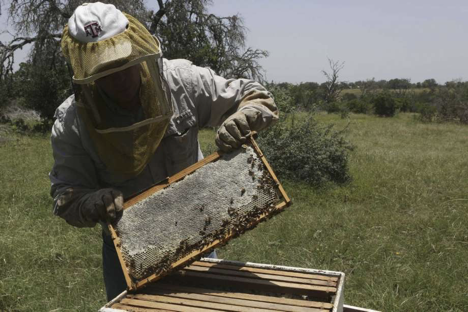
Boydean has turned me into a die-hard honey-lover. But over the years that he’s shared his bounty with us, I’ve learned some important stuff about honey. Here are important things to know if you too, like your honey!
First of all: Honey that can crystalize stores better than honey that can’t, since the high sugar concentration and enzyme's in crystallized honey prevents fermentation and the growth of microorganisms.
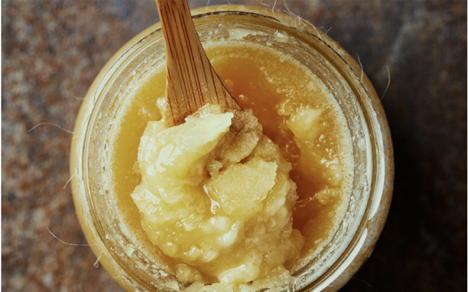
If you have a honey that doesn’t crystallize after a while, this is a honey that has likely been adulterated in some way. The common issue with store-bought honey is dilution. To increase profit margins, manufacturers cut it with high fructose corn syrup. I know…this is obscene! It’s always best to get your honey from a local bee keeper (often found at farmers’ markets).
So if you have crystallized honey, this is a GOOD thing. That says you have the real deal! And you can return it to its original liquid state by heating your container in a pan of water at a low temperature. Don’t ever resort to the microwave for this, though. You’ll kill all its trace elements, minerals (potassium, calcium), and pollen. Be aware that each time you reconstitute (melt) your honey, it will go darker. This doesn’t affect flavor or nutrition in any way. It’s just the nature of the beast (or bee, in this case).
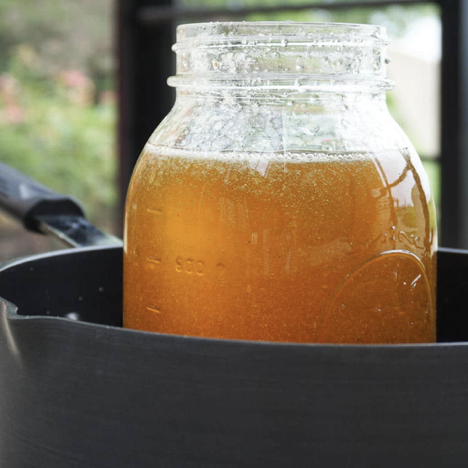
Honey consists of equal parts sucrose and fructose, and is 25-50% sweeter than sugar. Besides trace elements, minerals, and pollen, pure raw honey contains 22 amino acids. Raw Honey is the ONLY food that includes all the substances necessary to sustain life, including water. (Honey is 80% sugars and 20% water)
It adds such a lovely flavor to baked goods. But measuring it can be a pain in the neck. So to get honey out of a cup more easily and fairly mess-free, coat the cup with oil (coconut and olive are good) or butter. And when baking, you’ll want to set the oven’s temperature 25 degrees lower to prevent over-browning. Also note that honey softens cookie batters. Thus, if you want a crisper cookie, just add a little extra flour.
Honey can be substituted for sugar, and sugar substituted for honey. However, since honey is ounce for ounce sweeter than sugar, you need to use less of it in most recipes. Follow these guidelines for best results when you want to substitute sugar for honey:
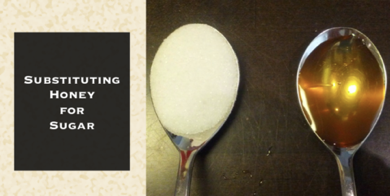
Finally, here’s a fun fact to know and tell at the dinner table: A single honey bee will produce approximately 1/12 teaspoon of honey in her lifetime. Knowing this causes even a deeper love and respect for this precious sweetener, don’t you think?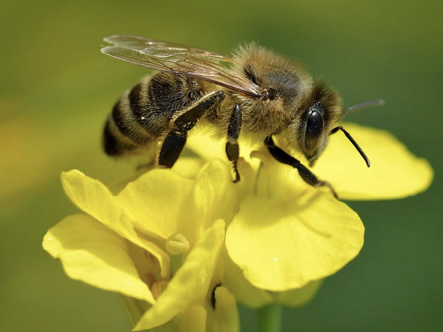
I’ll close with a wonderful and unique recipe for a treat that promotes healthy digestion as well as satisfies your sweet tooth. If you’ve never made honey ginger chews before, now’s the time!
Ingredients:
2 cups water
1/8 cup grated fresh ginger
3/4 cup superfine sugar
1/4 cup pure raw honey
4 tablespoons powdered sugar
1 tablespoon corn flour, (NOT cornstarch; Bob’s Red Mill is a good source)
Directions:

Boydean has turned me into a die-hard honey-lover. But over the years that he’s shared his bounty with us, I’ve learned some important stuff about honey. Here are important things to know if you too, like your honey!
First of all: Honey that can crystalize stores better than honey that can’t, since the high sugar concentration and enzyme's in crystallized honey prevents fermentation and the growth of microorganisms.

If you have a honey that doesn’t crystallize after a while, this is a honey that has likely been adulterated in some way. The common issue with store-bought honey is dilution. To increase profit margins, manufacturers cut it with high fructose corn syrup. I know…this is obscene! It’s always best to get your honey from a local bee keeper (often found at farmers’ markets).
So if you have crystallized honey, this is a GOOD thing. That says you have the real deal! And you can return it to its original liquid state by heating your container in a pan of water at a low temperature. Don’t ever resort to the microwave for this, though. You’ll kill all its trace elements, minerals (potassium, calcium), and pollen. Be aware that each time you reconstitute (melt) your honey, it will go darker. This doesn’t affect flavor or nutrition in any way. It’s just the nature of the beast (or bee, in this case).

Honey consists of equal parts sucrose and fructose, and is 25-50% sweeter than sugar. Besides trace elements, minerals, and pollen, pure raw honey contains 22 amino acids. Raw Honey is the ONLY food that includes all the substances necessary to sustain life, including water. (Honey is 80% sugars and 20% water)
It adds such a lovely flavor to baked goods. But measuring it can be a pain in the neck. So to get honey out of a cup more easily and fairly mess-free, coat the cup with oil (coconut and olive are good) or butter. And when baking, you’ll want to set the oven’s temperature 25 degrees lower to prevent over-browning. Also note that honey softens cookie batters. Thus, if you want a crisper cookie, just add a little extra flour.
Honey can be substituted for sugar, and sugar substituted for honey. However, since honey is ounce for ounce sweeter than sugar, you need to use less of it in most recipes. Follow these guidelines for best results when you want to substitute sugar for honey:

- 1 c sugar = ¾ cup honey minus ¼ c liquid OR plus 4 tablespoons flour plus ¼ teaspoon baking soda
- ½ cup sugar = 6 tablespoons honey minus 2 tablespoons liquid OR plus 2 tablespoons flour plus 1/8 teaspoon baking soda
- 1/3 cup sugar= ¼ c honey minus 1 ½ tablespoons liquid OR plus 1 ½ tablespoons flour plus 1/12 teaspoons baking soda
- ¼ cup sugar= 3 tablespoons honey minus 1 tablespoon liquid OR plus 1 tablespoon flour plus 1/16 teaspoon baking soda
Finally, here’s a fun fact to know and tell at the dinner table: A single honey bee will produce approximately 1/12 teaspoon of honey in her lifetime. Knowing this causes even a deeper love and respect for this precious sweetener, don’t you think?

I’ll close with a wonderful and unique recipe for a treat that promotes healthy digestion as well as satisfies your sweet tooth. If you’ve never made honey ginger chews before, now’s the time!
Homemade Honey Ginger Chews
2 cups water
1/8 cup grated fresh ginger
3/4 cup superfine sugar
1/4 cup pure raw honey
4 tablespoons powdered sugar
1 tablespoon corn flour, (NOT cornstarch; Bob’s Red Mill is a good source)
Directions:
GINGER
1. In a medium-sized pan, simmer grated ginger and water until half the water has evaporated (not more than half). Strain set aside. (The simmering may take approximately 30 minutes.)
2. Grease a small baking dish with coconut oil or butter and set aside.
HONEY- GINGER
3. In a clean, medium-sized pan, add the simmered ginger, superfine sugar, and honey; stir over low heat until the sugar has dissolved.
4. Bring to a gentle simmer and avoid stirring.
5. Using a candy thermometer, keep an eye on the temperature – allow the mixture to heat up to 255°F. Once this temperature is reached, remove from heat immediately and pour mixture into the buttered glass dish.
6. Once the mixture has cooled slightly, peel it out of the baking dish and using a sharp knife (you can warm it in water) slice the chews into bite-sized strips.
CANDY COATING
7. Combine powdered sugar and corn flour and mix well. Dust each candy piece in this mixture and store in an airtight container.
1. In a medium-sized pan, simmer grated ginger and water until half the water has evaporated (not more than half). Strain set aside. (The simmering may take approximately 30 minutes.)
2. Grease a small baking dish with coconut oil or butter and set aside.
HONEY- GINGER
3. In a clean, medium-sized pan, add the simmered ginger, superfine sugar, and honey; stir over low heat until the sugar has dissolved.
4. Bring to a gentle simmer and avoid stirring.
5. Using a candy thermometer, keep an eye on the temperature – allow the mixture to heat up to 255°F. Once this temperature is reached, remove from heat immediately and pour mixture into the buttered glass dish.
6. Once the mixture has cooled slightly, peel it out of the baking dish and using a sharp knife (you can warm it in water) slice the chews into bite-sized strips.
CANDY COATING
7. Combine powdered sugar and corn flour and mix well. Dust each candy piece in this mixture and store in an airtight container.
Recipe formatted with the Cook'n Recipe Software from DVO Enterprises.
Sources:
- www.mysanantonio.com
- www.honeyfanatic.com
- www.waxingkara.com
- www.sandiegohoney.com
- www.blogs.scientificamerican.com
- www.justeasyrecipes.com
 Alice Osborne
Alice Osborne
Weekly Newsletter Contributor since 2006
Email the author! alice@dvo.com
